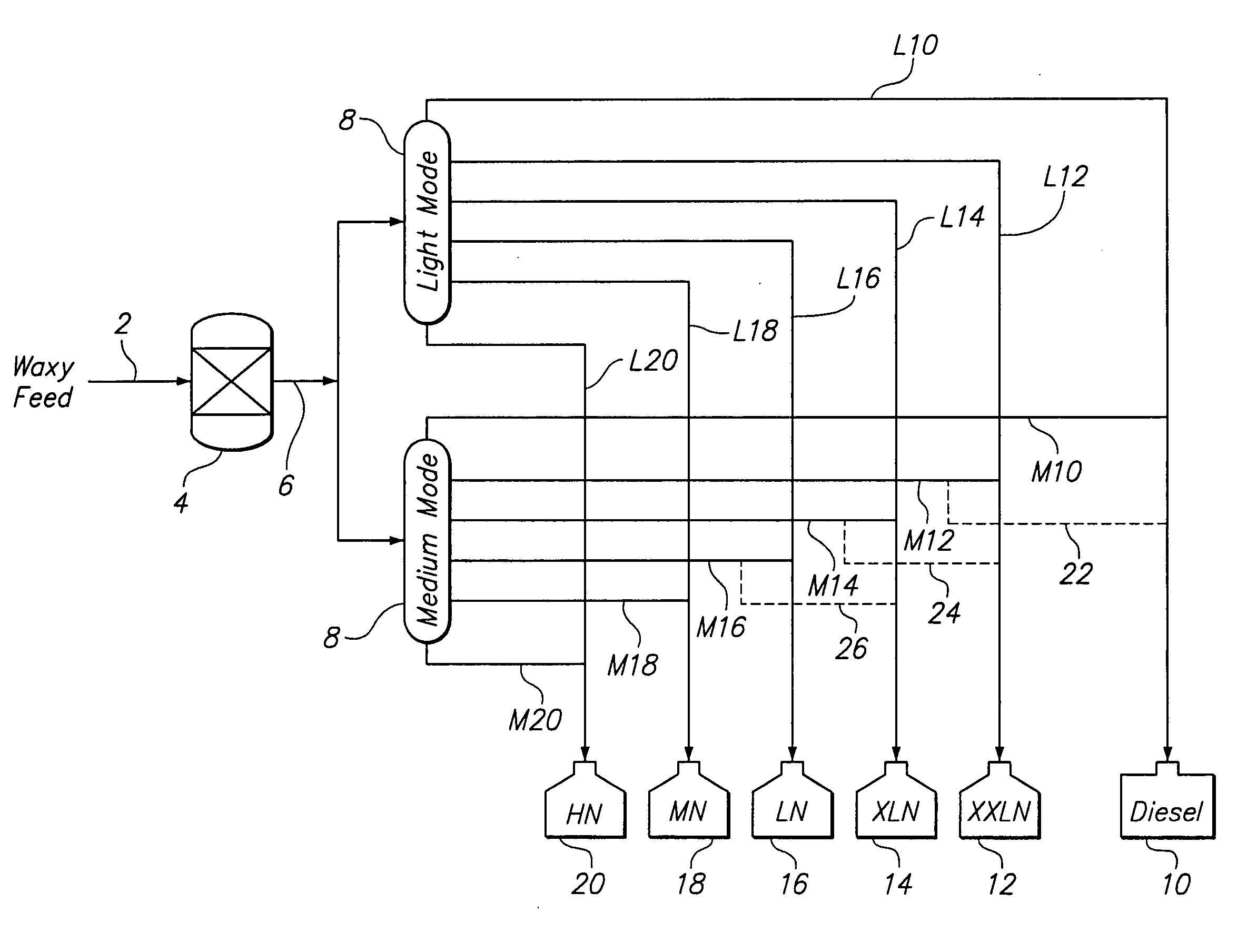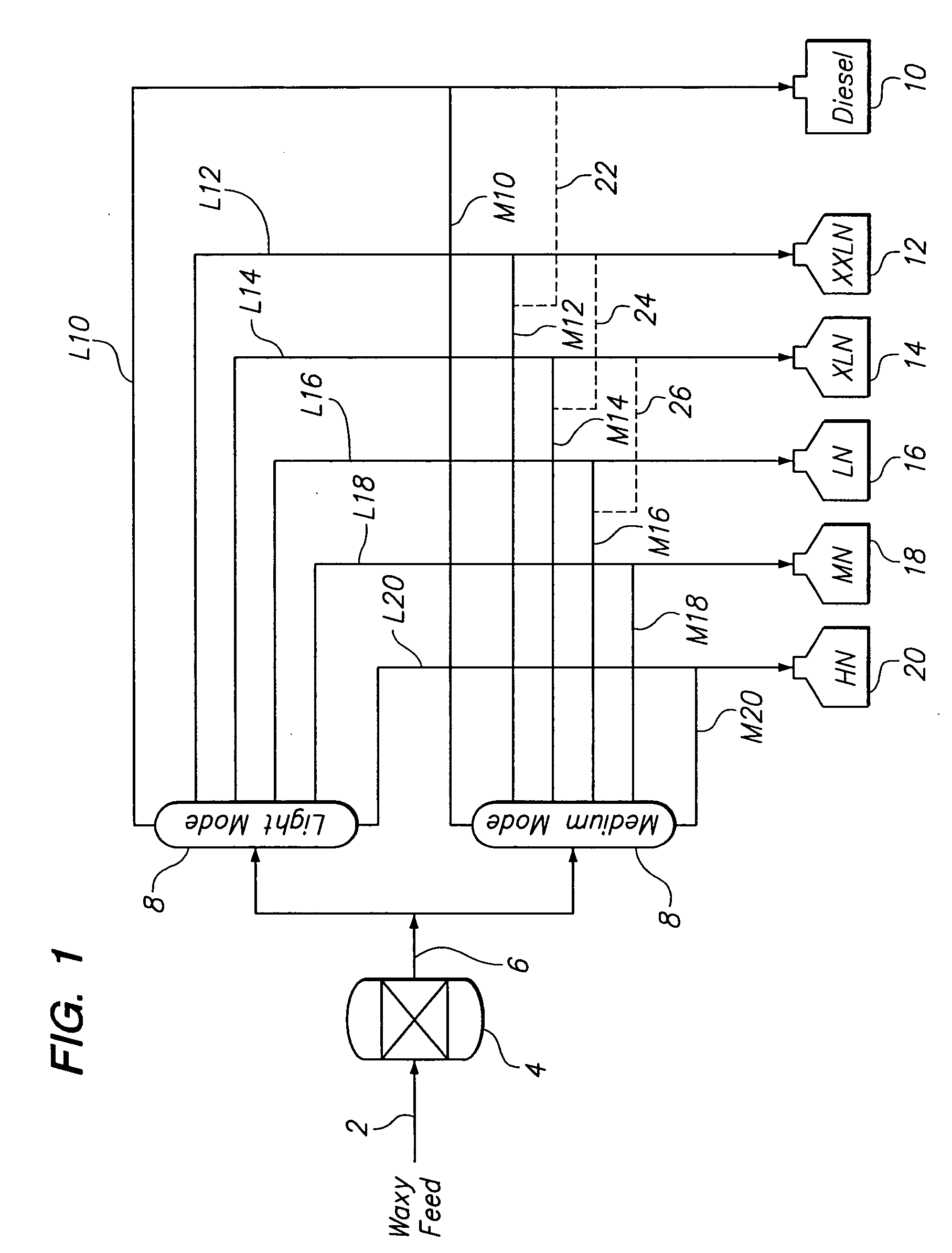Multiple side draws during distillation in the production of base oil blends from waxy feeds
a technology of waxy feed and distillation process, which is applied in the direction of petroleum wax refining, hydrocarbon oil treatment products, lubricating oil distillation, etc., can solve the problems of poor low temperature properties of feedstocks at the star
- Summary
- Abstract
- Description
- Claims
- Application Information
AI Technical Summary
Benefits of technology
Problems solved by technology
Method used
Image
Examples
example 1
[0055] A Fischer-Tropsch wax prepared over a cobalt based catalyst was hydrotreated. Upon analysis the boiling range distribution was found to be as shown in Table 1.
TABLE 1Fischer-Tropsch Wax Boiling Range DistributionD-6352 SIMDIST TBP (wt. %)° C.° F.T0.5295563T5342648T10356672T20380716T30402755T50442827T70488911T80516961T905561032T955831082T95.56321170
[0056] A broad boiling base oil was made from the Fischer-Tropsch wax described above by hydroisomerizing it over a Pt / SAPO-11 catalyst and subsequently hydrofinishing it over a Pt / Pd on silica-alumina hydrofinishing catalyst. The broad boiling base oil produced, which has a boiling point of 550° F. or above, was subsequently separated in a vacuum distillation tower operated in a light block mode and a medium block mode. The broad boiling base oil was 78.42 wt. % of the total yield of products out of the hydrofinishing reactor. Both distillation modes produced five fractions. The fractions with the highest cut point range in each ...
example 2
[0060] 50 / 50 blends of the fractions from the two different distillation modes in Example 1 were prepared. The distillation cut point ranges, product yields, and product properties produced by the blends are summarized in Table 4, below.
TABLE 450 / 50 Blended Products with Five Fractions50 / 50 BlendsL1 + M1L2 + M2L3 + M3L4 + M4L5 + M5ProductHeavyXLNLNMNHNType or BaseDieselOil GradeDistillation18.3929.1029.7716.656.09Yield, wt. %Gravity,47.643.9541.6540.136.2°APIPour−49−30−24.5−20.5−2Point, ° C.Viscosity1.5912.5874.2717.74821.62at 100° C.,cStViscosity—125143157158IndexNoack97.440.312.81.70Volatility,wt. %
[0061] Note that three of the blended base oil grades in this example had very high VI. The XLN, LN, and MN base oil grades all had a VI greater than the formula 28×Ln(Vis 100)+95.
[0062] When transported and blended together in storage tanks, a full base oil slate is produced. The blend of L1 and M1 was a good quality heavy diesel fuel. The other grades were all useful as base oil pr...
example 3
[0065] The same broad boiling base oil described in Example 1 was separated in a vacuum distillation tower operated in a light block mode and a medium block mode. Each mode produced six, instead of five fractions. As in Example 2, above, the fractions with the highest cut point range in each mode were distillation bottoms fractions.
[0066] The distillation cut point ranges, product yields, and product properties produced by the two distillations are summarized below. Table 5 contains the data from the light block mode distillation, and Table 6 contains the data from the medium block mode distillation.
TABLE 5Light Block Mode Distillation with Six FractionsLight Block ModeL1L2L3L4L5L6Cut Point Range, ° F.550-650650-700700-753753-900900-10501050+ Distillation Yield, Wt. %18.3914.3015.4830.6815.06 6.09Gravity, °API47.644.643.241.640.036.2 Pour Point, ° C.−49−33−27−24−20−2 Viscosity at 100° C., cSt1.5912.3172.9044.3767.95521.62Viscosity Index—121129144157158 Noack Volatility, Wt. ...
PUM
| Property | Measurement | Unit |
|---|---|---|
| boiling point | aaaaa | aaaaa |
| boiling point | aaaaa | aaaaa |
| kinematic viscosities | aaaaa | aaaaa |
Abstract
Description
Claims
Application Information
 Login to View More
Login to View More - R&D
- Intellectual Property
- Life Sciences
- Materials
- Tech Scout
- Unparalleled Data Quality
- Higher Quality Content
- 60% Fewer Hallucinations
Browse by: Latest US Patents, China's latest patents, Technical Efficacy Thesaurus, Application Domain, Technology Topic, Popular Technical Reports.
© 2025 PatSnap. All rights reserved.Legal|Privacy policy|Modern Slavery Act Transparency Statement|Sitemap|About US| Contact US: help@patsnap.com



